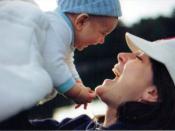Discuss and evaluate Bowlby?s theory on Attachment in the light of more recent studies in Psychology. How have these theories been applied in social work today? This paper will start with a brief insight into the period of history and studies that lead to Bowlby?s ideas. It will then make a full evaluation of his attachment and deprivation hypotheses, including detailed criticisms of his theory. Finally it will discuss how his research has affected certain areas of social work such as day care, adoption and fostering.
Bowlby was commissioned by the World Health Organisation in the 1950s to study the effects on child development of being raised within institutions, post World War 2. Bowlby?s initial report (Maternal Care and Mental Health, 1951) discussed the infant?s attachment to its mother, focussing on the effects of maternal deprivation. Bowlby believed that a secure mother-child bond throughout infancy was as important to the child?s mental health ?as vitamins and proteins are for physical health?.
At the time Bowlby?s work was considered to be highly controversial because it could be used as scientific proof for the commonly held maxim that ?a women?s place is in the home?.
Bowlby believed that babies were genetically programmed to form attachments with their mother in order to survive. Bowlby based his theories on earlier ethological research by Lorenz (1935). Lorenz? famous study of young goslings showed they needed to quickly recognise their primary caregiver and stay close to them. He called this process imprinting. Lorenz also discovered there was a critical period during which the goslings formed this attachment. Bowlby argued that a similar critical period where the synchrony between mother and child created an attachment. For most children, this attachment needs to be formed within the first six to twelve months. Infant behaviours...


